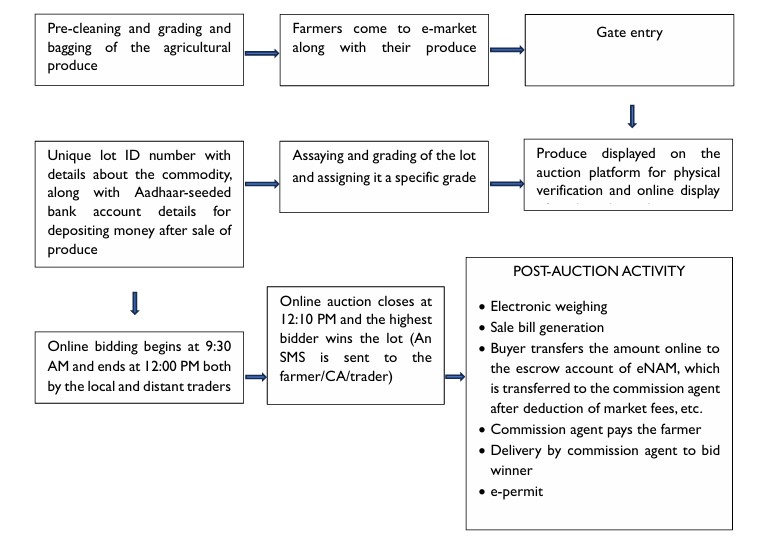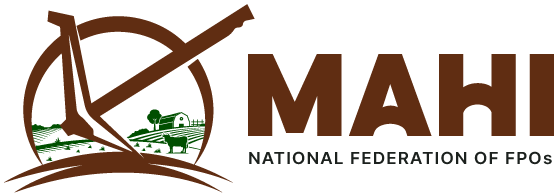By Mr.S.Vignesh Kumar, Mr. K.C. Gummagolmath, Mr. Satyendra Kumar , Mrs. S.B. Ramya Lakshmi
About e-NAM
The Electronic National Agriculture Market (e-NAM), launched on 14th April 2016, is a virtual
platform that integrates physical mandis across India, fostering a unified national market for agricultural
produce. It aims to resolve key inefficiencies in the agricultural marketing system, including fragmented
supply chains, high transaction costs, post-harvest losses, and limited price discovery mechanisms.
Initially piloted in 23 regulated markets across eight states, e-NAM has now expanded to 1,389 APMCs
in 23 states and four Union Territories
The Small Farmers’ Agribusiness Consortium (SFAC) under the Ministry of Agriculture and
Farmers Welfare is the nodal agency for implementing e-NAM. State Agricultural Marketing Boards
(SAMBs) work alongside national market infrastructure institutions to ensure smooth operations. The
platform standardizes trading procedures, enhances price transparency, reduces exploitation by
middlemen, and promotes real-time price discovery based on demand and supply. Hitherto, in a typical
public owned APMCs/ RMCs, the price discovery was confined to few traders, while in e-NAM Platform
there is scope for participation of a greater number of traders across the country and thus leading to
competitive price discovery
How it works? – The Process Flow

Status of Implementation
As of 28th February 2025, e-NAM facilitates e-trading of 219 commodities, including grains,
oilseeds, fruits, vegetables, and spices. Over 2,64,111 traders, 1,14,942 commission agents, and
1,78,47,254 farmers are registered on the platform, along with 4389 FPOs actively participating in
online trade. Haryana, Andhra Pradesh, Madhya Pradesh, Rajasthan, Telangana, and Uttar Pradesh have
seen significant farmer engagement
To support farmers during the COVID-19 lockdown, three key modules were introduced in April
2020:
- FPO Trading Module: Allows FPOs to trade from their collection centres, designated as "Deemed Markets" or "Sub-Market Yards."
- Warehouse-based e-NWR Trading: Facilitates trade through e-Negotiable Warehouse Receipts (e-NWR) from WDRA-accredited warehouses. In few States, these are warehouses are designated as Sub markets enabling direct trade. This prevents multiple handling of produce
- Logistics Module: Connects farmers with transportation services, with 2.3 lakh transporters and 11.37 lakh vehicles onboarded
Further, interoperability between Karnataka’s ReMS (Unified Market Portal-UMP) and e-NAM
enables inter-platform trade, expanding market access. The Platform of Platforms (POP), launched
on 14th July 2022, integrates 41 service providers, allowing farmers to sell beyond state borders while
benefiting from additional services like quality checks, logistics and warehousing
e-NAM and the role of Farmer Producer Organizations (FPOs)
FPOs, formed by groups of farmers, play a crucial role in collective production, procurement,
and marketing. Various agencies such as NABARD, SFAC, NCDC, SAUs, KVKs, and NGOs facilitate
FPO formation. Over 40,000 FPOs have been established nationwide, significantly benefiting small and
marginal farmers by providing production, technical, financial, and marketing support.
Recognizing the importance of market linkage for FPOs, the government integrated the FPO module into e-NAM. This module enables FPOs to register on e-NAM via its portal or mobile app, facilitating online trading directly from their collection centres. These centres are designated as “Deemed Markets” or “Sub-Market Yards,” allowing seamless aggregation and sale of produce.
Recognizing the importance of market linkage for FPOs, the government integrated the FPO module into e-NAM. This module enables FPOs to register on e-NAM via its portal or mobile app, facilitating online trading directly from their collection centres. These centres are designated as “Deemed Markets” or “Sub-Market Yards,” allowing seamless aggregation and sale of produce.
Trading Process through FPO Module
FPOs aggregate members’ produce at collection centres, conduct quality assaying, and create
trade lots. These lots are listed on the e-NAM platform, where traders place bids. Once a transaction
is finalized, a sales agreement is generated, detailing commodity type, quantity, and price. Payments are
processed online to the FPO’s bank account, which then distributes earnings among farmer members.
Additionally, FPOs can access an e-NAM dashboard for trade-related reports and market insights.
For FPOs to trade on e-NAM, certain prerequisites must be met:
- State laws must allow outside mandi transactions via collection centres.
- FPOs require essential infrastructure, including computers, internet connectivity (minimum 5 Mbps), and weighing/assaying equipment.
- Trained manpower must manage sampling, documentation, and digital transactions.
Currently, 4389 FPOs are registered on e-NAM, with Rajasthan pioneering the first transaction in 2020.
Since then, numerous FPOs have successfully traded via e-NAM, demonstrating its effectiveness in
improving market access and price realization for farmers.
With continuous enhancements like inter-platform trade and the POP initiative, e-NAM is steadily transforming India’s agricultural marketing landscape, making it more transparent, efficient, and farmer centric.
With continuous enhancements like inter-platform trade and the POP initiative, e-NAM is steadily transforming India’s agricultural marketing landscape, making it more transparent, efficient, and farmer centric.
Table 1. Price differential realized by FPOs for Different commodities across the country
| Sl. No. | Name of the FPO | Commodity | Price received on e-NAM (₹/Quintal) | Price in open market (₹/Quintal) | Difference in price (₹) |
|---|---|---|---|---|---|
| 1 | Kisan Agro Producer Company Ltd (DKAPPCO), Paralakhemundi, Odisha | Cashew | 10,336 | 10,000 | 336 (3.36) |
| 2 | Girimala Farmers Producer Company Ltd. (GFPCL), Modasa, Gujarat | Channa | 10,000 | 9,500 | 500 (5.00) |
| 3 | Yermunai Collective Farmer Producer Company Ltd. (YCFPCL), Gobi, TamilBadu | Copra | 9,500 | 8,500 | 1000 (11.76) |
| 4 | Mahakaushal Farmers Progressive Self Reliant Producer Company Ltd, Seoni, Madhya Pradesh | Maize | 1325 | 1220 | 105 (8.61) |
Leveraging e-NAM for Federations
The Table 1 illustrates how e-NAM has empowered FPOs to recognize price differentials
across platforms, consistently resulting in better price realization for those trading on the platform.
This perspective can now be extended to Federations of FPOs, applying the same approach for similar
benefits.
Leveraging e-NAM to support FPO federations can transform agricultural marketing by enabling bulk transactions, improving price realization, and facilitating collective marketing. Federations can aggregate produce from multiple FPOs, creating larger trade volumes that attract institutional buyers, processors, and exporters. This collective approach enhances their negotiation power, leading to better prices and reduced dependency on local intermediaries.
Leveraging e-NAM to support FPO federations can transform agricultural marketing by enabling bulk transactions, improving price realization, and facilitating collective marketing. Federations can aggregate produce from multiple FPOs, creating larger trade volumes that attract institutional buyers, processors, and exporters. This collective approach enhances their negotiation power, leading to better prices and reduced dependency on local intermediaries.
Many FPOs face challenges in sustaining their businesses and integrating digital infrastructure.
However, forming federations and actively participating in e-NAM can significantly enhance their
viability. Federations, particularly those focused on common commodities, can achieve greater
economies of scale, streamline operations, and improve overall efficiency, making digital integration
more effective and sustainable.
Suggestions and Conclusion
While e-NAM has shown benefits through select FPO case studies, further improvements are
needed for its effectiveness.
- Increasing awareness and participation among processors, exporters, and bulk buyers through market-led extension and regular capacity-building programs. The flow of information and sensitization becomes more efficient and effective with the involvement of federations.
- Strengthening infrastructure such as Modern Assaying and Grading facilities, Cold Storage and Warehouses. Further, integrating value chains, ensuring a steady commodity flow, and promoting transparency to enhance market efficiency.
- Expanding e-NAM provisions to sub-yards to benefit distant farmers and encouraging FIGs, CIGs, FPOs, Federations and cooperatives for better participation and operational efficiency. Additionally, deploying CIF agents across market yards can boost interstate trade volumes.
While the government has harnessed digital platforms like e-NAM for agricultural marketing,
the focus must now shift to identifying and engaging the right target groups. Emphasizing a group
based approach will strengthen the concept of federations, enabling them to leverage e-NAM more
effectively for better price realization and a robust business ecosystem. This, in turn, will enhance
the sustainability of Farmer Producer Organizations (FPOs) and deliver greater benefits to a larger
network of member farmers

